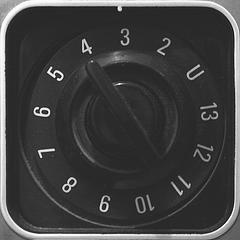Throwing all the pieces out on the table, we connect the dots to make pictures. It’s a child’s game, creating figures out what look like a random set of numbered points. We tend to visualize the network of our social graph as a series of connected points. The pictures that emerge from those connections tell a story about our lives and experiences.
One of the interesting things about random sets of dots is that we tend to group them based on proximity, similarity, closure and continuation. We project pictures on to the dots, and once we see a particular picture, sometimes it’s hard to realize that someone might put the same set of dots together into something entirely different. It could even be an image that has the exact opposite meaning as the picture we see.
There are a couple of words used to describe a word that can mean the opposite of itself. Here are some examples of Antagonyms (or Contranyms):
Overlook: to pay attention to, to inspect (“We had time to overlook the contract.”) vs. to ignoreOversight: Watchful and responsible care vs. An omission or error due to carelessness
It’s the context that tilts the meaning of the word this way or that.
When you think about the set of people you may be connected to within a large company, you can overlay several kinds of connections. A person may be a colleague, they might be in the same division, have the same pay grade, be part of a project, be a friend, or even a relative. In fact, we make a virtue out of the idea that the people we work with could also be our friends. Many companies like to talk about their employees as being like a family.
Google tested their Buzz product inside the walls of their company. No doubt it was used for work, play and a whole range of unforeseen kinds of communication. After a while all those modes of communication began to blend together. The boundaries between them broke down. Just as email and IM are used for personal and business purposes, Buzz would naturally be used in the same way. From a business perspective, the dots were connected into a powerful image of collaboration and efficiency. Twitter/FriendFeed clearly worked great as an enterprise application.
The personal, public and business realms are overlapping images that can be mapped to the same set of dots. However, it’s the exclusive disjunction of these sets that defines the boundaries. In some cases, the boundaries need to be strong and impenetrable. These are the cases Google didn’t consider carefully enough in their launch scenario. Other times a co-worker becomes a friend, or someone you went to school with becomes a colleague. Or maybe you just decided to start following your company’s CEO on Twitter. The context of the interaction tilts the meaning of the connection. There’s not a bright line separating our private, public and business lives that can be applied as a definitive rule.
Google launched Buzz as a consumer product, but tested it as an enterprise product. Although they plan to quickly integrate it into their office application suite. But like all messaging tools it will have a public and a private mode. It will address and contain personal, public and business conversation threads. And by flowing data from a user’s social circle and the real-time flow of Buzz (effectively a ping server) into their search algorithm, results pages can be personalized by social graph in real time.
Meanwhile, SalesForce.com introduces Chatter to the enterprise and rolls it out at no extra charge to all employees on the internal network. And while it will start inside the enterprise, Chatter will quickly expand to the boundaries and begin to cross over. From a business perspective, it’ll be used to turbo-charge collaboration and create real-time communication for project teams and business units. But very quickly you’ll see friends sending messages to each other about meeting up for lunch, and a public-personal communications channel will be opened within the enterprise. And the circles will connect and widen from there.
Here are a couple more Contranyms:
clip (attach to) – clip (cut off from)
cleave (to cut apart) – cleave (to seal together)
Salesforce.com calls itself the leader in Customer Relationship Management and Cloud Computing. Chatter may just be the communication medium that ultimately contains both CRM and its opposite number, VRM. Vendor Relationship Management is a reaction to the data toolsets belonging to the enterprise and not to the individual customer.
In a narrow sense, VRM is the reciprocal — the customer side — of CRM (or Customer Relationship Management). VRM tools provide customers with the means to bear their side of the relationship burden. They relieve CRM of the perceived need to “capture,” “acquire,” “lock in,” “manage,” and otherwise employ the language and thinking of slave-owners when dealing with customers. With VRM operating on the customer’s side, CRM systems will no longer be alone in trying to improve the ways companies relate to customers. Customers will be also be involved, as fully empowered participants, rather than as captive followers.
If you were to think about what kind of infrastructure you’d want to run VRM on, Salesforce.com would be ideal. To run the mirror image of CRM, you need the same set of services and scale. The individual Chatter account could be the doorway to a set of VRM services. I can already see developers using the Force.com platform to populate a VRM app store.
Some corporations will attempt to maximize the business value of each individual worker, stripping out all the extraneous human factors. Chinese walls will be erected to keep the outside from the inside, the personal from the business, and the public from the private. But when you put messaging and communications tools into the hands of people they will find ways to talk to each other— about work, life, play, the project, and the joke they just heard at the water cooler.
4 Comments






